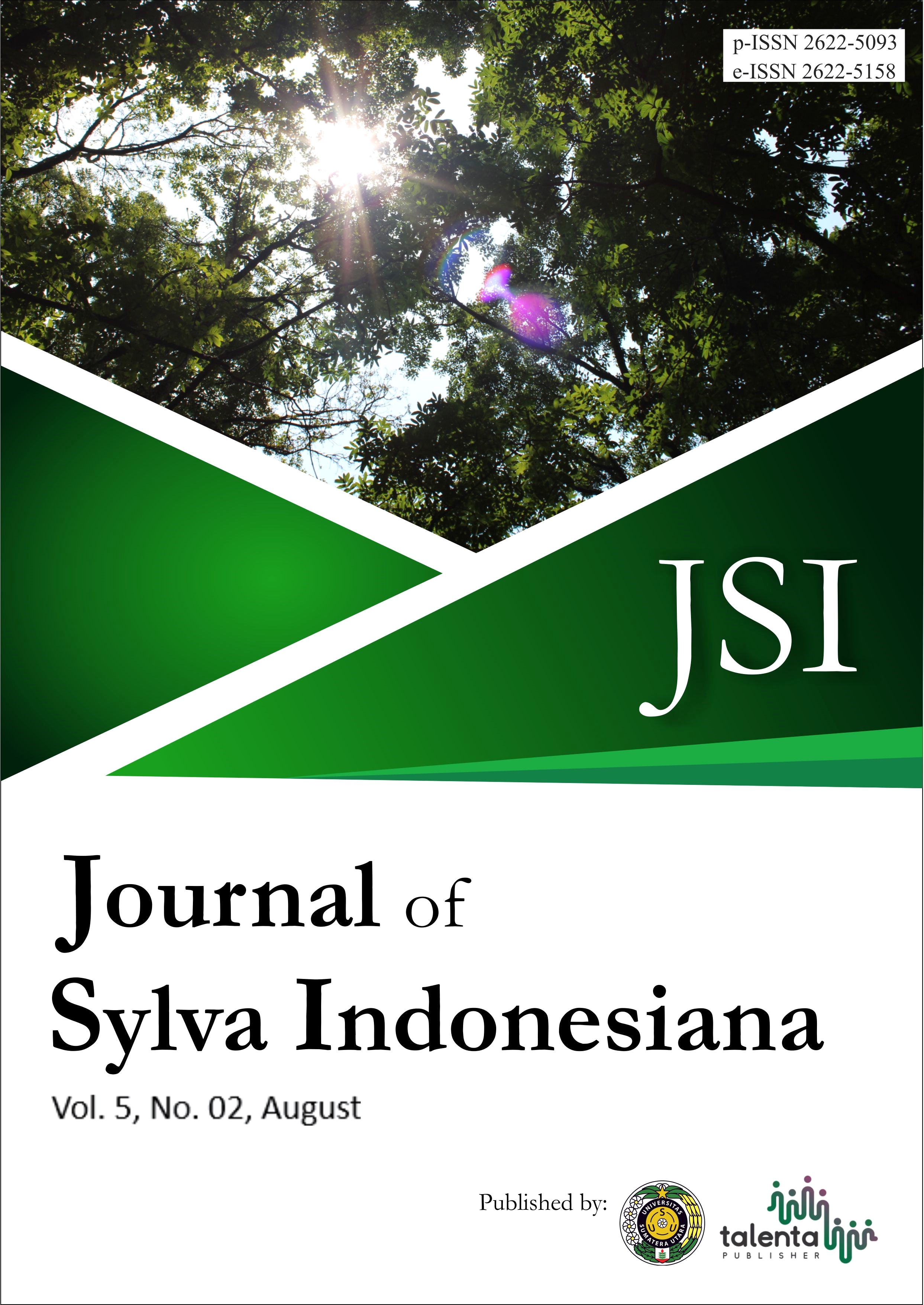Similarity Analysis of Understorey Plant Species in Forest Areas
DOI:
https://doi.org/10.32734/jsi.v5i02.7375Keywords:
Forest Area, Protected Forest, Similarity Index, Understorey Composition, Understorey PlantAbstract
Many forests have substantial understorey plants. These plants have an important contribution to soil and water conservation. The similarity index determines the resemblance of species structure and composition in a community. This research is aimed to see the impact and relationship of changes in the allocation of forest areas to the similarity of understorey species. The research was conducted using the line plot sampling method, sized 2 m x 2 m, with the understorey plants observed have been measured from germination to young plant (height 1.5 m). The number of plots in the plantation forest is 480 plots, protected areas 224 plots, and natural forest 96 plots. Determination of the number of understorey plots based on the minimum representative area curve. A Similarity Index was performed to analyze the data. The results indicated that there is an impact of changes in the forest area on the similarity of understorey species. It is known from the low similarity index value at the research location. It is due to the differences in environmental factors at the two locations such as air humidity, air temperature, the intensity of sunlight, and different patterns of forest area management.
Downloads
References
Bray, JR dan JT Curtis. “Penghabisan komunitas hutan dataran tinggi di Wisconsin selatan,†Monograf Ekologis vol. 27, pp. 325-349. 1957.
Hikmatyar, M. F., Ishak, T. M., Pamungkas, A. P., Mujahidah, S. S. A., & Rijaludin, A. F. “Estimasi karbon tersimpan pada tegakan pohon di hutan pantai pulau kotok besar, bagian barat, kepulauan seribu,†Al-Kauniyah: Jurnal Biologi, vol. 8, no. 1, pp. 40-45. 2015.
Erna., Lies. I., dan Alamsyah, F. “Analisis Keanekaragaman Jenis Tumbuhan Bawah di Hutan Lindung Jompi (Kelurahan Wali Kecamatan Watopute, Kabupaten Muna Sulawesi Tenggara),†Jurnal Ecogreen, vol. 3, no. 1, pp. 49–58. 2017.
Wahyuono, S., Etik, E.W.H., Siti, M.W. “Keanekaragaman dan Pemanfaatan Tumbuhan Bawah pada Sistem Agroforestri di Perbukitan Menoreh, Kabupaten Kulon Progo, Palembang,†Jurnal Manusia dan Lingkungan, vol. 23, no. 2, pp. 206–215. 2016.
Azwar, F., & Adi, K. “Keragaman Jenis Tumbuhan Bawah pada Berbagai Tegakan Hutan Tanaman di Benakat, Sumatera Selatan,†Jurnal Penelitian Hutan Tanaman, vol. 10, no. 2, pp. 85–98. 2013.
Brunet, D., Vrscay, E. R., & Wang, Z. “On the mathematical properties of the structural similarity index,†IEEE Transaction on Image Processing, vol. 21, no. 4, pp. 1488-1499. 2011.
Zhang, L., Zhang, L., Mou, X., & Zhang, D. “FSIM: A feature similarity index for image quality assessment,†IEEE transactions on Image Processing, vol. 20, no. 8, pp. 2378-2386. 2011.
Kusmana, Metode Survey dan Interpretasi Data, ed. 1, Ed: Robi Deslia Waldi, IPB Press. 2017. ISBN: 978-602-440-040.
Rahman, I. U., Hart, R., Afzal, A., Iqbal, Z., Ijaz, F., Abd_Allah, E. F., & Bussmann, R. W. “A new ethnobiological similarity index for the evaluation of novel use reports,†Appl. Ecol. Environ. Res, vol. 17, no. 2, pp. 2765-2777. 2019.
Schubert, A., & Telcs, A. “A note on the Jaccardized Czekanowski similarity index,†Scientometrics, vol. 98, no. 2, pp. 1397-1399. 2014.
Novak, D., Batko, M., & Zezula, P. “Metric index: An efficient and scalable solution for precise and approximate similarity search,†Information System, vol. 36, no. 4, pp. 721-733. 2011.
Kaur, A., Kaur, L., & Gupta, S. “Image recognition using coefficient of correlation and structural similarity index in uncontrolled environment,†International Journal of Computer Applications, vol. 59, no. 5, 2012.
Ponomarenko, M., Egiazarian, K., Lukin, V., & Abramova, V. “Structural similarity index with predictability of image blocks,†In 2018 IEEE 17th International Conference on Mathematical Methods in Electromagnetic Theory, pp. 115-118, 2018.
Nafchi, H. Z., Shahkolaei, A., Hedjam, R., & Cheriet, M. “Mean deviation similarity index: Efficient and reliable full-reference image quality evaluator,†Ieee Access, vol. 4, pp. 5579-5590. 2016.
Lestari, S., Fitmawati, F., & Wahibah, N. N. “Keanekaragaman durian (Durio zibethinus Murr.) di Pulau Bengkalis berdasarkan karakter morfologi,†Botanic Gardens Bulletin, vol. 14, no. 2, pp. 29-45. 2011.
Paulangan, Y. P., Fahrudin, A., Sutrisno, D., & Bengen, D. G. “Keanekaragaman dan kemiripan bentuk profil terumbu berdasarkan ikan karang dan lifeform karang di Teluk Depapre Jayapura, Provinsi Papua, Indonesia,†Jurnal Ilmu dan Teknologi Kelautan Tropis, vol. 11, no. 2, pp. 249-262. 2019.
Pamoengkas, P., & Zamzam, A. K. “Komposisi Functional Species Group Pada Sistem Silvikultur Tebang Pilih Tanam Jalur Di Area Iuphhk-Ha Pt. Sarpatim, Kalimantan Tengah,†Jurnal Silvikultur Tropika, vol. 8, no. 3, pp. 160-169. 2017.
Sangwan, A. K. “Physiological behaviour and yield evaluation of colocasia under agri-horti-silviculture system,†HortFlora Research Spectrum, vol. 3, no. 2, pp. 114-121. 2014.
Steinbauer, M. J., Dolos, K., Reineking, B., & Beierkuhnlein, C. “Current measures for distance decay in similarity of species composition are influenced by study extent and grain size,†Global Ecology and Biogeography, vol. 21, no. 12, pp. 1203-1212. 2012.
Kolaman, A., & Yadid-Pecht, O. “Quaternion structural similarity: a new quality index for color images,†IEEE Transactions on Image Processing, vol. 21, no. 4, pp. 1526-1536. 2011.
Downloads
Published
How to Cite
Issue
Section
License

This work is licensed under a Creative Commons Attribution-NonCommercial 4.0 International License.



















